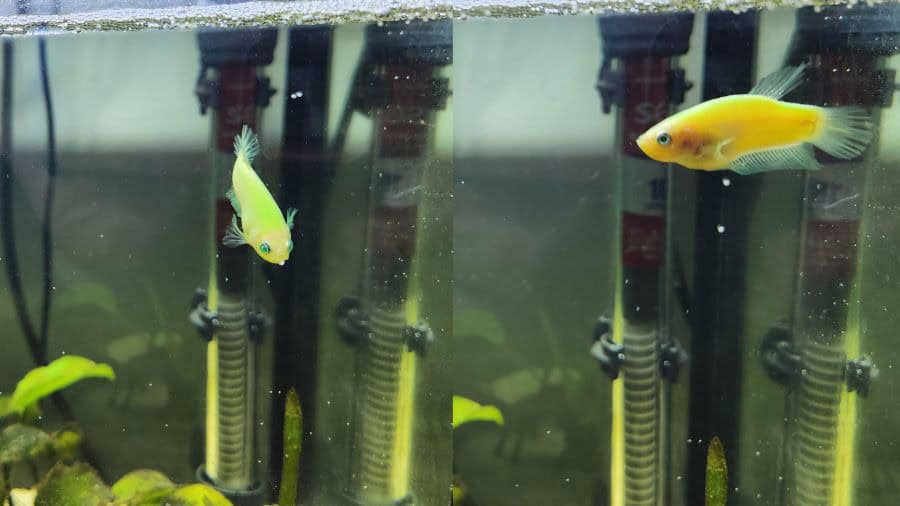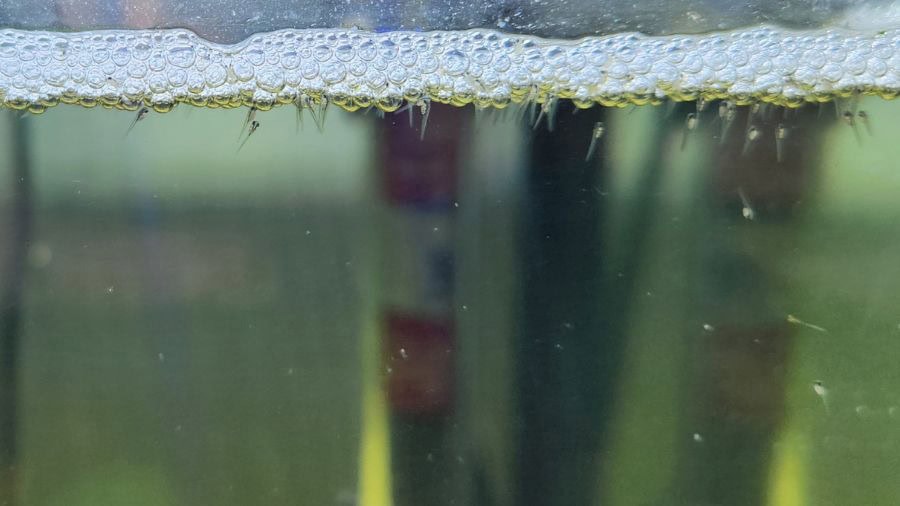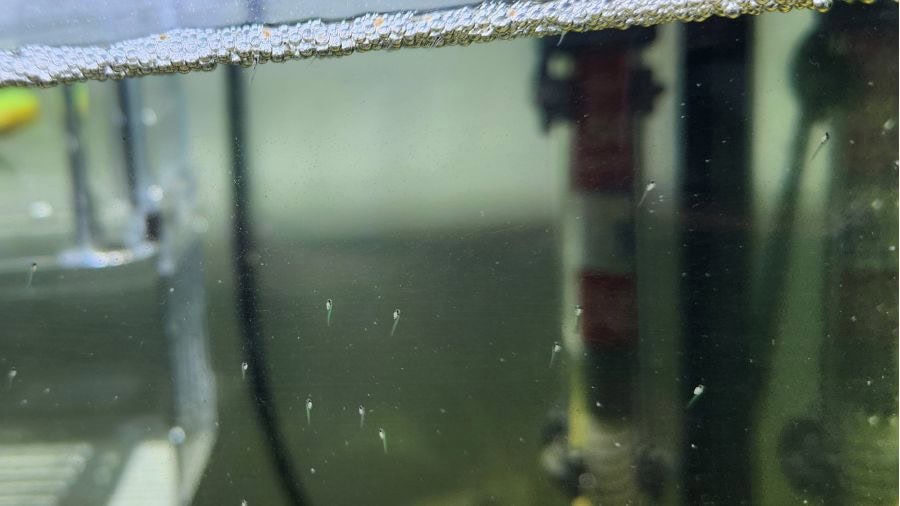My Betta Fish Laid Eggs What Do I Do?
Firstly, I have to provide some background on why eggs were such an unexpected experience. So, I have never owned Betta fish and know very little, mainly only the basics, really. My boyfriend went with me to the local pet shop and fell in love with these GloBetta fish. We got the two “females” and everything we needed for the setup.
PS: These GloFish Betta fish look amazing with a blue light on. We usually switch to the blue light for night time.

After a few days, I saw one female making a bubble nest, and I thought, “Shame, she is ready to have babies. We should really look at getting them a boyfriend one day when my other tank frees up.” My idea was also to start breeding with them eventually, and I started investigating how the male would look, with their Neon color and flowy tail.
I never knew you could get short-fin Betta fish called Plakat, and the pet shop did not sell us two females but a male and a female. So I got to the tank in the morning and saw eggs in those bubbles. Still, it did not occur to me that one could be a male. In my mind, Betta males had these impressive, long, flowing fins and tails.
I felt sorry for “her”; “she” was being such a good mom, picking up the falling “unfertilized” eggs and placing them back into the bubbles, silly me. Only the next morning, when I saw the babies, did panic hit me like a plank between the eyes. I was excited and freaking out at the same time as I realized how unprepared I was for the babies.
What I Bought / What You Need
As I walked into the pet shop, I naturally had the attitude of, “Two females, yeah, right!” I explained to the pet shop that the breeder they got these GloFish Bettas from was incorrect when he told them they were all females and were the short-fin variety.
Anyway, at the pet shop, I got the following items:
- A self-floating multifunctional isolation box (extra-large)
- A tub of Microworm starter culture (they only had one; I wanted three)
- A tub of Banana worm starter culture
- Brine shrimp eggs (5g)
I went to a grocery store and got the following things:
- Pronutro (maize porridge cereal)
- Black Pantyhose/stockings (the cheapest I could find)
- Yeast
I am currently using the isolation box to keep the male and female in, and it would work well for future spawning as I can keep the male and female separated and then remove the divider for them to do their thing. That was a good buy, and I must mention that I am not using it as intended.
I removed the horizontal part and stuck it with the divider to make a big barrier. I placed this improvised barrier vertically in the isolation box to provide both Bettas with more room, as I am not a fan of Bettas in small spaces.
I thought of using the microworm starter in the beginning stages of the baby fry as they are tiny and would be easy for the babies to eat. Unfortunately, they only had one tub, so I got the Banana worm starter as an extra. The brine shrimp eggs will be the first live food in time for the babies, as the worms will still take a few days to get going properly.
The cereal and yeast I got I will use to get the worm cultures going properly. The black stockings I used to cover the bottom part of the filter in my Betta tank. The bottom part of my filter is where the water of the tank gets sucked into, and I don’t want any babies getting sucked up. If you have an old pair, you can cut the toe part off and use it.
If you have a sponge filter at home, you can use that instead of going through the stalking step. Unfortunately, if you buy a new sponge filter, the new filter has no beneficial bacteria and could cause havoc with your water, so it’s better to use an old one or cover the water intake of your filter as I did.
How Does The Egg-Laying Process Start?

The egg-laying process starts with the male building a beautiful bubble nest. Sometimes, females also build nests, but theirs aren’t as impressive as the male’s bubble nest. Spawning will occur with the male and female, and it looks like he wraps his body around the female in quite an aggressive embrace. Unfortunately, I missed all this.
As he embraces her, eggs are released, and he swims to catch them and place them in the bubbles. This embrace is continued with catching and placing eggs. Once they are done spawning, you must remove the female from the tank or tub (if you were trying to breed with them). The male sees any other fish as a potential threat to his babies as he catches eggs and places them back into the bubble nest.
The Betta eggs will hatch in a day or two (depending on the water temperature). The baby Betta fry will look like they are hanging from the bubbles or sitting on the side of the tank. The male will continue to scoop them up with his mouth and place them back near the bubbles.
Looking closely at the fry, you will see their yellow egg sack, which you can spot around their tummy area. They will feed off this from the first few days after hatching. You can remove your male Betta from the tank or tub after the babies have hatched. I left him in longer while I went to the shop to try and source food for the babies.
What I Did After The Eggs Hatched

After getting the female and male into the isolation box, I prepared the live food for the babies, as it would take me a day or two for anything to hatch or start. I also have to mention that I am keeping the isolation box in the tank where the babies are, as I don’t have an additional heater and don’t plan on getting any additional tanks.
I forgot to mention that the male Betta, busy caring for babies and everything, will most likely not eat anything during this time. It is completely normal. Once separated for a few hours, he will start eating again.
What To Feed The Fry
Once the yellow egg sack of the Betta fry has been depleted, usually on day two or three, you can start feeding your fry. You have many options to start with. People like using Vinegar Eels (you can also purchase a starter culture of this), baby Brine Shrimp, or Microworms to start with.
You can then progress to other live food options like Banana Worms, Daphnia, Grindal worms, etc. It is up to you and what you have access to. I also have to mention that if you keep the parents in the tank like I am, they will most likely also eat some of the live food. Be careful when feeding them their normal food in addition to the live food.
Brine shrimp fed with normal food (simultaneously) is known to cause bloating in Betta fish and could have severe results. Brine shrimp should be given to Betta fish in moderation, so rotate the live food you feed your fry. Rotating your live food will also help you maintain a steady supply.

Betta fry have very small stomachs and can only eat a bit at once. Therefore, it is best to add only a little bit at a time when adding live food to the tank. You can feed your Betta fry their very small, wiggly meals three to five times daily.
I have started all my cultures to provide me with a supply of live food for the baby fry. Most people plan when they want their Bettas to spawn and plan ahead with live food available when the baby Betta fry hatch. I will definitely continue with all my live food, as live food is great nutrition for adult Bettas and my other fish.
